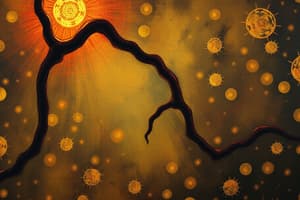Podcast
Questions and Answers
What is the primary energy currency within cells?
What is the primary energy currency within cells?
- GTP
- ATP (correct)
- ADP
- AMP
In glycolysis, what is the immediate product of the breakdown of glucose?
In glycolysis, what is the immediate product of the breakdown of glucose?
- Fructose 1,6-bisphosphate
- Acetyl CoA
- Oxaloacetate
- Pyruvate (correct)
Which stage of glycolysis involves initial reactions in the cytosol?
Which stage of glycolysis involves initial reactions in the cytosol?
- Transition phase
- Preparatory phase (correct)
- Terminal phase
- Elongation phase
What process produces approximately 95% of the total ATP yield during oxidative phosphorylation?
What process produces approximately 95% of the total ATP yield during oxidative phosphorylation?
Which enzyme is responsible for driving the synthesis of ATP during the electron transport chain?
Which enzyme is responsible for driving the synthesis of ATP during the electron transport chain?
Which process involves the redistribution of electrons through an electron transport chain, leading to the formation of a proton gradient for ATP synthesis?
Which process involves the redistribution of electrons through an electron transport chain, leading to the formation of a proton gradient for ATP synthesis?
What is the main purpose of fermentation in cells under anaerobic conditions?
What is the main purpose of fermentation in cells under anaerobic conditions?
Which stage of cellular respiration involves the formation of succinyl CoA among its key features?
Which stage of cellular respiration involves the formation of succinyl CoA among its key features?
In cellular respiration, where does substrate-level phosphorylation primarily occur?
In cellular respiration, where does substrate-level phosphorylation primarily occur?
During cellular respiration, what is the role of carboxylation in the Krebs Cycle?
During cellular respiration, what is the role of carboxylation in the Krebs Cycle?
Flashcards are hidden until you start studying
Study Notes
Cellular Respiration
Cellular respiration is a series of metabolic processes that convert food into energy. It occurs in the cytoplasm and takes place through three main stages: glycolysis, the electron transport chain, and the citric acid (Krebs) cycle. These processes involve multiple enzymes and substrates, and they result in the generation of ATP, which serves as the primary energy currency within cells.
Glycolysis
Glycolysis is the first stage of cellular respiration, occurring both in aerobic and anaerobic environments. This process involves the breakdown of glucose into pyruvate, releasing a net gain of two ATP molecules per glucose molecule. Glycolysis can be divided into three main phases:
- Preparatory phase: Initial reactions in the cytosol.
- Elongation phase: Secondary reactions in the mitochondria involving acetyl CoA.
- Terminal phase: Final reactions in the mitochondria.
Electron Transport Chain
The electron transport chain is responsible for generating most of the ATP used by the organism. It is a membrane-bound system consisting of a series of redox carriers called complexes I to IV, each transferring electrons from NADH to molecular oxygen. This process produces approximately 95% of the total ATP yield during oxidative phosphorylation. The proton motive force generated during this process drives the synthesis of ATP by the ATP synthase enzyme.
Anaerobic Respiration
An anaerobic environment lacks sufficient oxygen to support aerobic respiration, so alternative pathways are required. These alternative pathways generate less ATP compared to oxidative phosphorylation. In the absence of oxygen, cells may employ fermentation to break down glucose into lactate, ethanol, or other end products depending on the species. Fermentation results in minimal ATP production; however, it does help maintain the cell's integrity in low-oxygen conditions.
ATP Production
ATP is the primary energy source for all cellular activities, including growth, reproduction, and maintenance of homeostasis. During cellular respiration, ATP is produced through the following three main mechanisms:
- Substrate-level phosphorylation: Occurs in the initial stages of catabolism, where energy stored in high-energy bonds of substrates such as glucose is transferred to ADP, forming ATP.
- Oxidative phosphorylation: Involves the redistribution of electrons through an electron transport chain, with the formation of a proton gradient across the inner mitochondrial membrane. This gradient powers the synthesis of ATP via ATP synthase.
- Photophosphorylation: In photosynthetic cells, light energy is converted into chemical energy through a photochemical reaction, driving the synthesis of ATP using water as an electron donor.
Krebs Cycle
The citric acid (Krebs) cycle is the third stage of cellular respiration and occurs in the mitochondrial matrix. It builds upon the initial products of glycolysis and generates additional ATP while also producing precursor molecules required for biosynthetic purposes. Key features of the Krebs cycle include:
- Initial reactions form citrate.
- An electron acceptor accepts an electron.
- Dehydration forms a double bond.
- Carboxylation uses carbon dioxide.
- Reduction reverses the reaction.
- Final reactions form succinyl CoA.
Studying That Suits You
Use AI to generate personalized quizzes and flashcards to suit your learning preferences.




